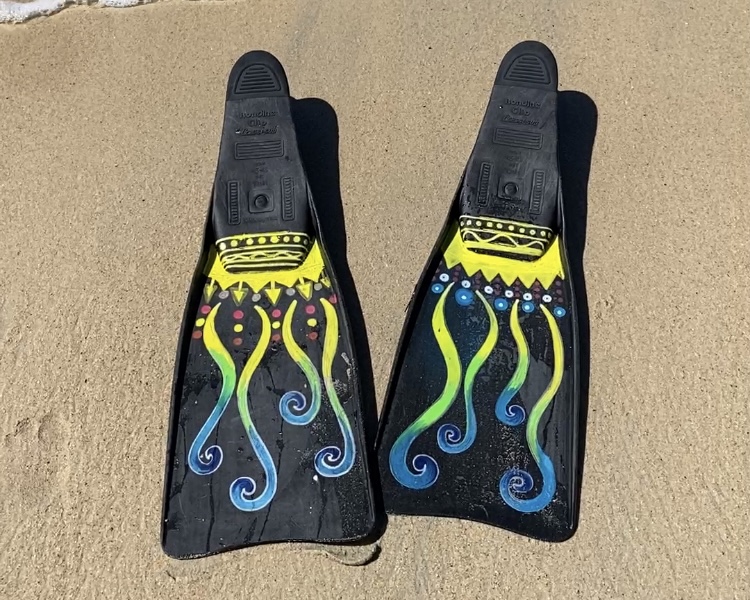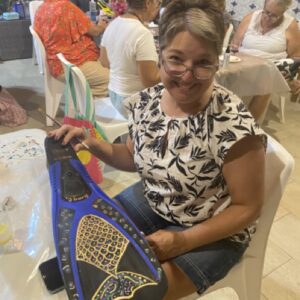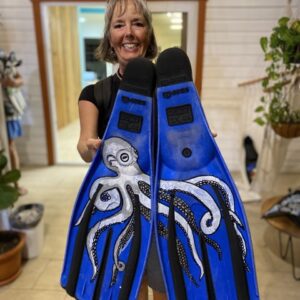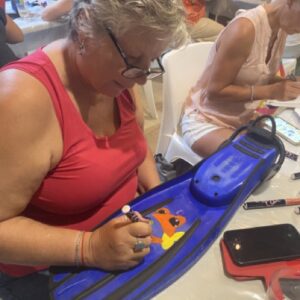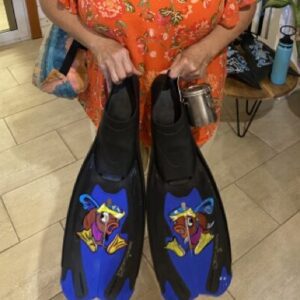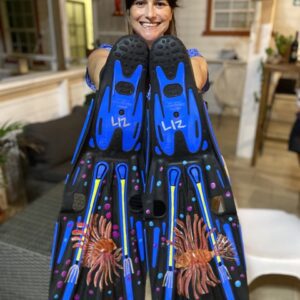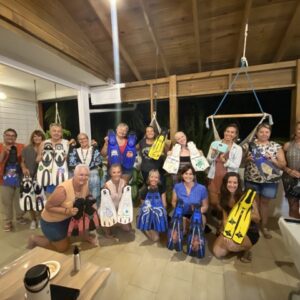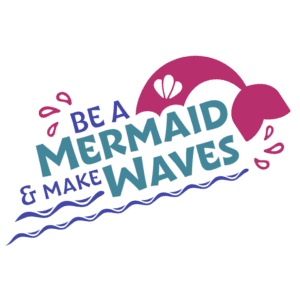Topic: Blogs
7 Reasons Why Roatan is Great for Diving
If you’re searching for an unforgettable diving experience, look no further than Roatán. This tropical island offers many reasons for why it’s the perfect destination for divers seeking adventure, natural beauty, and marine biodiversity. Let’s explore the enchanting wonders that make Roatan great for diving.
1. World-Class Dive Sites in Roatan:
Roatan is a diver’s playground. As part of the Mesoamerican Barrier Reef, it has an abundance of dive sites to suit every preference and skil level. This makes Roatan great for diving! Whether you’re a new or an experienced diver, there’s a dive site that will leave you stunned. From vibrant coral reefs teeming with marine life, to jaw-dropping wall dives and intriguing shipwrecks. Each dive in Roatan promises a new and exciting underwater adventure.
Want to know which dive sites are our favorite? Check out our Top 10 Roatan Dive Sites list.
2. Endless diving opportunities year-round:
One of the remarkable features of Roatan is its year-round diving opportunities. Thanks to its great location the climate is very steady throughout the year. Roatán is great for diving at any time of the year. With warm temperatures and minimal rainfall through most of the year, you’ll experience excellent visibility and calm waters. This ensures an unforgettable diving experience whenever you choose to visit. If you’re interested in when the best time to come visit Roatan is, check out our blog post.
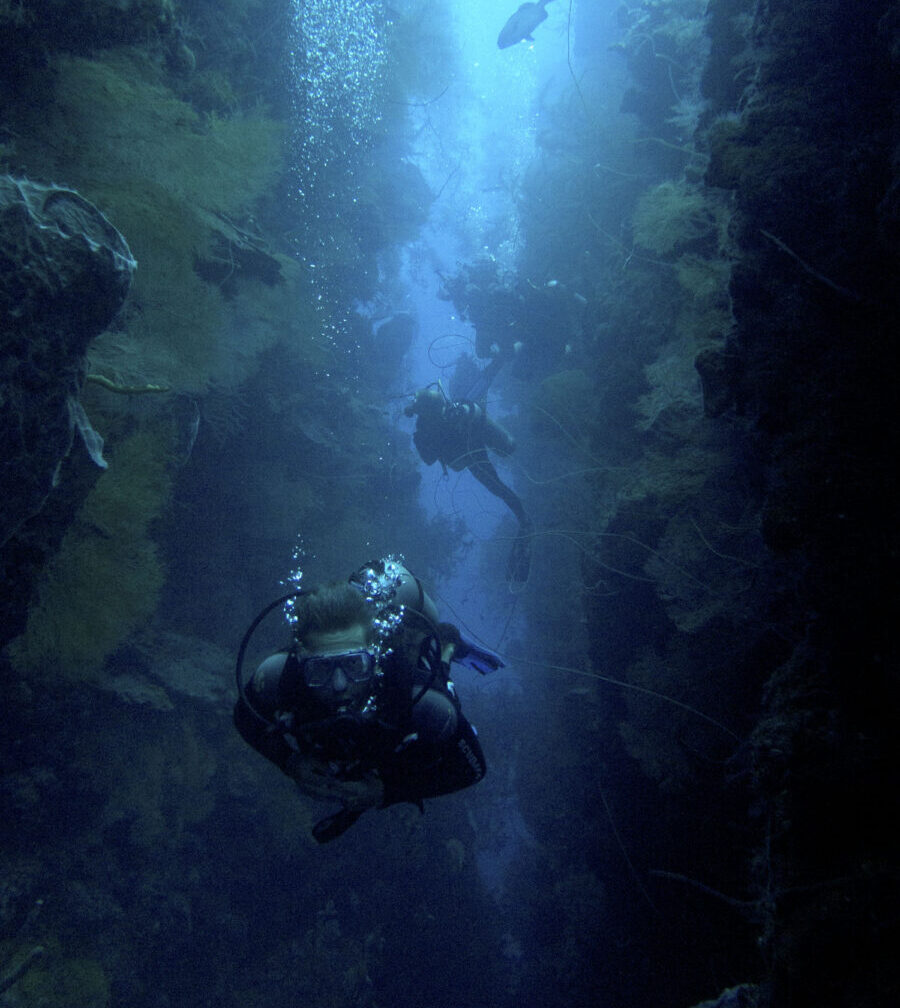
3. Easy access and short travel:
Getting to dive sites in Roatan is a breeze. Sun Divers is located right at the doorstep of many of our favorite dive sites. So, it’s often just a few minutes by boat. Short boat rides mean less time commuting and more time exploring the captivating underwater world. We offer two tank morning dives and afternoon explorations. If you’re up for an adventure we can also full-heartedly recommend our night dives. Thanks to the short commute you’ll still make it back on time for a nice dinner afterwards. See our favorite places to eat!
4. Ideal for learning:
Roatan is the best place to get scuba certified. The year-round calm and clear waters of Roatan create a comfortable and welcoming environment. This means you focus on learning to scuba dive or advancing your skills without also trying to navigate tricky dive conditions. Roatan is an ideal destination for beginners and those looking to expand their diving proficiency. You can sign up for any of our courses any time of the year. Check out the courses available at Sun Divers and get your PADI in Roatan! At Sun Divers, you’ll find a team of experienced staff and instructors from diverse backgrounds. We are ready to guide and support you on your diving journey
5. An abundance of marine biodiversity:
Roatan is a haven for marine life enthusiasts. As soon as you’re beneath the surface, you’ll be greeted by an awe-inspiring world of biodiversity. Encounter majestic eagle rays gracefully soaring through the water. Catch a glimpse of sea turtles gracefully gliding by. And witness a great variety of colorful tropical fish species in their natural habitat. Into the smaller stuff? You can also find an array of macro life from millimeter size nudibranchs to interesting small shrimp and crab species. Roatan’s rich ecosystem is truly a treasure of marine wonders waiting to be explored.
6. A protected marine park:
One of the reasons why Roatan is great for diving and has such breathtaking marine biodiversity is its conservation efforts. The island is surrounded by a protected marine park. At Sun Divers, being ‘always eco-active’ is a core value and we’re proud to sponsor the Roatan Marine Park, as well as donate the use of our boats and employee volunteer time for coral restoration activities. We actively promote and practice sustainable diving. Emphasizing respect for marine life and habitats is imperative to us and we require all of our divers to support the annual Roatan Marine Park access fee ($10) which goes toward the protection of the park. By choosing to dive with Sun Divers, you contribute to the preservation and protection of Roatan’s fragile marine ecosystem, ensuring its beauty can be enjoyed for generations to come. We share this passion and dedication with our dive community and offer a Coral Ambassador course in which you can learn to help with coral restoration.
7. More than just diving!
Roatan isn’t just a diver’s paradise. It also offers a great hotel and restaurant scene that adds to the island’s appeal. After a day of diving and exploring the underwater wonders you can treat yourself to a culinary adventure on land. Roatan boasts a range of dining options that cater to various tastes and preferences. Charming seaside seafood shacks are serving up the freshest catch of the day. And upscale restaurants offer international cuisine. There’s something to satisfy every taste.
Discover our 10 Top Restaurant Recommendations While in Roatan!
What are you waiting for?
Roatan is great for diving – That is undeniable! This island embodies everything and more that you wish for when diving. Embark on an unforgettable journey with Sun Divers and immerse yourself in the magic of Roatan’s underwater realm. Let the island’s natural beauty and captivating marine encounters leave its mark on you. Roatan is great for diving. Come discover its hidden treasures with us. Contact us so that we can put together en epic dive trip itinerary for you!
Do You Need a Wetsuit to Dive in Roatan?
Roatan is a Caribbean paradise known for its scenic and beautiful reefs. Its warm tropical waters attract a diversity of marine life and many divers each year. But are Roatan’s waters so warm that you don’t need a wetsuit to dive in Roatan?
Generally, yes, most people need a wetsuit to dive in Roatan. But depending upon the year and personal preference, the type of exposure suit you need can vary from full 3mm to even just a rashguard.
Let’s explore the 5 factors that can help you decide if you need a wetsuit to dive in Roatan and what type of wetsuit is best for you:
1. Water temperature
While Roatan enjoys cozy tropical waters throughout the year, the temperature can vary slightly depending on the season. The average water temperature ranges from 80°F (25°C) to 84°F (29°C). The water tends to be warmer during the summer months from May to September. The temperature slightly drops during the winter months from October to April. If you’re on the “get-cold easy” side or plan to do multiple dives a day, a wetsuit can provide added comfort and insulation.
Most divers choose to wear a 2.5mm shorty or even just a rash guard and leggings during the summer months. And then a full 3mm wetsuit during the winter months. People who get colder might also opt to add an extra layer of protection with a hooded vest under their wetsuit to dive in Roatan. Then there are those who seem to run hot year-round and opt for just a shorty or rash guard any time of year. This gives them ultimate freedom and mobility – but isn’t for the faint of heart!
If you want to find out more about the weather in Roatan throughout the year, read our post on: When is the best time to dive in Roatan?
2. Dive duration
The longer you’re in the water, the colder you might get. For short dives in shallow water, you’ll maybe be comfortable enough without a wetsuit. But for longer dives a wetsuit can help regulate your body temperature and protect you from potential heat loss. It’s really annoying to not enjoy your dive because you’re too cold. You might also get cold, when you’re doing multiple dives a day. At Sun Divers, all fun dives are at least 60 minutes. Consider how long your dives and surface intervals will be for your decision on if you need a wetsuit to dive in Roatan or not.
3. Dive depth
Another factor to consider when deciding whether you want to wear a wetsuit to dive in Roatan is your dive depth. As you descend into deeper waters, the temperature drops. In Roatan, the water temperature starts to cool when you descend beyond approximately 30 to 40 ft (9 to 12 m). You might feel the temperature drop a bit, especially if you spend an extended amount of time down there. If you’re into deep dives, Roatan has a few interesting dives that you might want to check out such as Hole in the Wall and our wrecks, The Aguila and Odyssey. It is important to note that the exact temperature variation can vary depending on factors such as the season and current as well.
In order to dive below 60 ft (18m) you need to be Advanced Open Water certified or do it as an Adventure Dive. You can find out about the benefits to get Advanced Open Water certified in our blog post.
4. Personal comfort
Every diver has their own preferences and comfort levels when it comes to ideal water temperatures. Some divers may feel comfortable diving without a wetsuit in Roatan’s warm waters. Others may prefer the added comfort, protection and warmth that a wetsuit provides. Ultimately, it is a personal choice based on your individual comfort and needs. Regardless of your decision, we always recommend wearing a rash guard or mineral-based sunscreen to protect your skin from the sun’s rays. If you do wear sunscreen please avoid petro-chemical sunscreens.
You can find out more about reef safe sunscreen.
5. Protection
Besides temperature regulation, wetsuits also offer additional benefits such as protection against the sun’s harmful rays or jellyfish stings. Diving in tropical environments closer to the equator means being exposed to intense sunlight, and wearing a wetsuit can provide a layer of UV protection for your skin. Luckily, we don’t see many jellyfish in Roatán. But occasionally, they hang out at the surface during night dives. If there is any, a wetsuit will protect you from being stung.
Gloves are not allowed
Did you know that in the Roatan Marine Park, the use of gloves during diving is not permitted? There are good reasons for this regulation. The main purpose of the Roatan Marine Park is to protect and preserve the delicate marine ecosystem of this incredible reef. This includes the corals and other marine life. Gloves can unintentionally cause damage. The texture of gloves can damage corals and other fragile organisms when touched. Gloves may also give divers a false sense of security. This can lead to careless contact with delicate structures. Eco friendly and sustainable diving practices are a top priority at Sun Divers. By respecting the “no gloves” policy, we can contribute to the conservation efforts of the marine park and ensure that no one is “touching, taking or teasing” the wildlife.
We’ll help you choose
At Sun Divers, we understand that divers have different preferences when it comes to thermal protection and sun exposure. Our experienced staff will guide you and give you recommendations based on current water conditions, your individual preferences, and the dive site characteristics. We offer a variety of different style and thickness wetsuits to rent from including 3mm full wetsuits, shorties and a variety of rash guards.
If you prefer to purchase your own wetsuit we are a certified Scubapro dealer and we offer deals, as well as direct shipping to Sun Divers customers.
Whether you choose to dive with a wetsuit, a rash guard, or without any additional protection at all, discover the beauty of our underwater world and embark on unforgettable diving adventures in Roatán with Sun Divers. We prioritize safety, small group diving and epic adventures.
So, do you need a wetsuit to dive in Roatán? The choice is yours, and we’re here to support you every step of the way as you explore the wonders beneath the surface of the Caribbean Sea. Contact us for more information.
How to Choose From the Best Dive Shops in Roatan
Dive Shops in Roatan are like Starbucks cafes in the U.S.: there’s one on every corner!
Just google ‘best dive shops in Roatan’ and over 50 different Roatan dive centers pop up. Some are boutique operations and others are all-inclusive. Some boast large boats for big groups and others focus on smaller, more personalized experiences. With all the choices, what’s a diver to do? If you’re finding it difficult to decide which Roatan dive shop to entrust your dive vacation to, evaluate your options using this guide on How to Choose from the Best Dive Shops in Roatan.
Full disclosure, this guide was created by Sun Divers Roatan. Why? Because while we’d love for everyone to dive with us, we know that our island is a world-class diving destination with many reputable Roatan dive centers to choose from. While there’s a dive center for everyone, not all dive centers are created equal. And what makes a great dive center to you might be different for another diver. So we’re presenting this guide to help you find the best dive shop in Roatan for YOU!
Here are 5 criteria to help you choose from the best dive shops in Roatan. You can also use this criteria to assess dive centers in any dive destination!
5 Criteria to Choose from the Best Dive Shops in Roatan
1. Location, Location, Location
Location is a top consideration when deciding which of the best dive shops in Roatan is just right for you. Roatan is made up of several villages and the most popular destinations for divers include West End, West Bay, Sandy Bay and Camp Bay. Each ‘village’ (or neighborhood) has its own character and vibe, as well as natural beauty and local amenities. You can find options for great Roatan dive shops in all these areas. Here’s a few ways to assess location:
Proximity to Popular Dive Sites: Roatan has a fringing reef with literally hundreds of moored dive sites surrounding the island.
The Northside of the island is sheltered from the prevailing winds, creating ideal dive conditions almost year-round. So, most of the popular dive sites are located on this side of the island – particularly in the northwest where West End Village and West Bay Beach are located. In West End, Roatan dive shops are going to be more centrally located to the majority of dive sites on the Northside. West Bay, Roatan dive shops and Sandy Bay dive shops will be closer to their respective areas.
However, the most popular dive site in Roatan, Mary’s Place, is ironically located on the Southside of the island. It is exposed to the easterly winds and thus typically has more waves and surface current. The topography of the reef and marine life on the Southside can also differ. This side of the island tends to have more dramatic deep walls and swaying soft corals. While the Northside is known for its extensive plateau with exciting swim throughs and channels carved through it. Some dive centers, including Sun Divers, travel to the Southside when we have either perfectly flat seas or northern winds make the conditions more ideal on this side. Read about ‘Southside Days’ here.
If Mary’s Place Roatan is on your bucket list and your dive shop can’t take you there, you can always do a day of diving with Barefoot Cay. This Roatan dive resort is located right by the dive site and also has an amazing poolside restaurant to spend the rest of the day.
Close to the action (or not!): Depending upon your vacation style, you’ll want to find a dive center (and lodging) that is in a Roatan village with the right vibe for you.
West End village might just be your vibe if you like to travel more like a local but still have access to great cuisine and entertainment. Akin to a sleepy beach town with character, West End has a few boutique hotels and tons more vacation rentals. You can walk to lots of great beach front restaurants – many featuring live music and other special events throughout the week.
If an all-inclusive Roatan dive resort with beautiful beach views is more your style, West Bay will be for you. The waters are turquoise, the sands white and the beach is bustling! Most hotels have an affiliated dive center on site for convenience. Forewarning, this area is a hot spot for large groups of cruise shippers and the beach can be crowded with both visitors and vendors.
If you want to feel more remote, but still within a quick jaunt to the happening spots, then you might consider Sandy Bay. This is a primarily residential neighborhood along the beach with a few vacation rentals and lodges with small dive shops. There are also a few local restaurants, but most of the lodges also have fantastic dining spots on site. You will likely need a rental car or a hired driver for most activities and to access the best beaches and restaurants.
And if you really want to get off the beaten path, look to Roatan’s East End. Here you’ll find eco resorts and undeveloped beaches for a more organic and rustic feel to your vacation.
Sun Divers is located in West End Village, Roatan on the shore of Half Moon Bay. We’re smack dab in the middle of over 70 different dive sites on the Northside and make it a point to take you to as many different dive sites as possible. When conditions allow, we will head out to explore more remote locations like Mary’s Place on the Southside, Roatan’s East End dive sites more remote locations like the seamounts and Cayos Cochinos. We’re neighbors with the iconic beach bar Sundowners and the Beach House boutique hotel, with whom we have a Dive & Stay packages available May through November. This little corner of West End is a real chill vibe and you could never leave. But if you do want to explore the best restaurants and bars – we’re just a beachy stroll away.
2. Dive Group Organization
Save yourself from frustrating dives by asking the Roatan dive centers that you’re assessing how they organize their fun dive groups.
Be sure to find out about the group sizes and number of people per boat when doing your research. Specifically, ask what the diver to divemaster ratio is for fun dives. Obviously the less fun divers assigned to a divemaster, the less likely you are to have to wait your turn to see cool stuff. And the less likey you’ll find fins in your face!
How the groups are organized matters as well. Find out if groups are arranged by skill level. If you’re into photography, see if there’s an opportunity to dive with other photographers or to even organize a photography dive.
If you are a student yourself, ask about the course ratio. While some PADI courses allow for up to 8 students per instructor – we believe that courses are more manageable for instructors and students get more personal attention when the ratio is 4 students to instructor or less.
When it comes to group size, we believe less is more! Our fun dive groups are kept relatively small at no more than 6 divers per guide. We organize groups by skill level and interest whenever we can, and also keep track of where everyone dives so that we can make sure you see a wide variety of Roatan diving. Courses are capped at 4 students per instructor to allow for more personalized attention even in a group setting.
3. The Type of Roatan Dive Center
There are many different types of dive shops in Roatan. Each offer a different environment (or “vibe”) and customer service experience. Each also has different amenities and course offerings. Here are a few examples of the type of dive shops in Roatan you can find:
- Boutique Dive Centers: These are smaller operations that focus mostly on recreational diving and courses. The boats are smaller with a capacity of around 10 people compared to 20+. Many offer 3-4 dives per day and cater to a personalized experience. These centers cater to folks who are visiting Roatan with the primary focus to dive and explore as much as they can. You’ll get a mix of experienced and well-traveled divers, along with younger people who have a newfound passion for scuba diving. The most popular boutique West End dive shops include Sun Divers and Roatan Divers.
- Dive Resorts: These centers are usually connected to hotels. Dive resorts are most prevalent in West Bay and tend to cater toward large groups and families. Many offer all-inclusive deals and also have amenities in common with the hotels they’re located within such as a pool, restaurants, gym and beach lounge chair access. Most of the Roatan dive resorts are located on West Bay beach. Some of the all inclusive resorts there include Mayan Divers and Infinity Divers. In Sandy Bay, you’ll find Anthony’s Key resort – the first dive resort on the island. And on the southside of the island, Coco View which is also one of the longest standing resorts and caters to underwater photographers.
- Instructor Development Centers: These operations offer recreational diving, but also focus heavily on training programs for divemasters and instructors. These centers will have a youthful, international vibe with young people who come from around the world to become dive professionals. On the boat, you will usually find a mix of fun dive groups with students who are doing their professional training. Many of our divemasters move on to become instructors with Go Pro Caribbean.
- TEC Centers: Similar to dive pro training centers, TEC centers offer niche instruction in technical diving. The centers that offer technical dive training in Roatan, also offer recreational diving, as well as professional training. Roatan Tec Center is one of the longest standing TDI certification centers on Roatan.
Sun Divers is a boutique dive center focused on curating epic dive trips for recreational divers. No one’s feeling like a number here. We take great care to pair you with divers of similar skills & interest, and make sure to show you a wide variety of dive sites. No heavy lifting required here! We set up your gear for your on the boats and will store all of your personal gear for you securely for the duration of your dive trip.
If you’re a student, you’ll learn from one of our experienced PADI scuba diving instructors and we always keep our groups small to ensure plenty of personal attention.
4. Quality of Gear and Boats
Don’t be afraid to ask questions about the type of gear stocked by the dive shops that you’re considering. Here are some questions to consider asking:
- What is the brand/model of the BCDs, regulators and wetsuits?
- When was your equipment last replaced?
- Do you use weight integrated BCDs or weight belts?
- How often do you conduct hydrostatic testing and visual inspections on your tanks? Hydrostatic requirements can be different based upon region, but typically should be conducted every 5 years. Visual inspections should be conducted annually. impeccable
At Sun Divers, we have a strict commitment to quality, whether it’s our all-star team, our impeccable boats and facilities, or the top-rated SCUBAPRO rental equipment we offer. Check out the details on our BCDs, regulators, fins, wetsuits and masks available for rent. And take a look at our custom dive boats built for comfort and speed.
5. Environmental & Social Responsibility
As beautiful as coastal communities like Roatan are, they face a number of unique environmental and socioeconomic challenges. While tourism and scuba diving are economic growth engines for our island, they do also contribute to increased pollution and pressure on our reefs. And as coastal communities have moved away from harmful commercial overfishing, that workforce has had to find new ways to make a living.
That is why it’s important to find a Roatan dive center that conducts its operations in an environmentally friendly way, as well as supports local conservation efforts.
A few considerations:
- Is the Roatan dive center you’re assessing a supporter of the Roatan Marine Park either as a sponsor or Coral Restoration center?
- Do they support any other local conservation efforts or local nonprofits?
- Do they promote eco-friendly diving guidelines on their website?
- Do they have a sustainability program?
We’re on a mission to not only be the best dive shop in Roatan, but to also make the biggest difference. We are sponsors of the Roatan Marine Park, as well as a RMP Coral Restoration center. We’re proud supporters of the Bay Island Conservation Association and we also run our own scuba scholarship program for island girls in partnership with Roatan Peer Health Exchange and PADI. We also host the island’s premier Charity Golf Tournament event which raises money for the SOL Foundation and has earned us the prestige of hanging the Golden Buoy in our dive shop!
Other Considerations for Choosing the Best Dive Shop in Roatan for You:
- What do other customers say about them? Check out TripAdvisor and Google Reviews.
- How quickly do they respond to your inquiry?
- How thorough is the information they provide?
- Do they offer multi-dive packages? When it comes to dive services, you get what you pay for. So while cheaper doesn’t equal better, it
- Do they offer any unique experiences such as trips to Mary’s Place, Cayos Cochinos or other remote areas?
Check out what our divers have to say about us on TripAdvisor! If we sound like the best dive shop in Roatan for you, shoot us an email and let’s start planning the most epic Roatan dive vacation ever!
5 Reasons to Get PADI Advanced Open Water Certified
Are you weighing the cost vs. benefit of getting your PADI Advanced Open Water certification? If so, you’re not alone. When you become open water certified, you’re technically able to do any recreational dive. So you might be thinking ‘why get my advanced?’
But we promise, you learn and experience something new with the PADI Advanced Open Water certification – whether you’re a new open water diver or have been exploring depths for decades. And the more training you have, the safer a diver you’ll be, which is never a bad thing. Plus, the course is only two days, requires minimal self study time and is just plain fun to do.
Not convinced yet? Here’s a few good reasons that we think will convince you to get your PADI Advanced Open Water. And hopefully you’ll do it in Roatan!
1. Elevate your expertise
Whether you’re still new to diving or already have hundreds of dives logged, the PADI Advanced Open Water course presents the perfect opportunity to build upon the fundamental skills you have acquired. It enables you to expand your knowledge of dive theory and skills proficiency, so that you’re well-equipped for the challenges and wonders that lie beneath the surface.
The PADI Advanced Open Water certification is fun and flexible, and it takes a more hands-on approach to learning. You learn by diving: No written exams required! Instead, you have informative briefings before and after each dive, and you practice achieving dive objectives and safety protocols.
You can gain a deeper understanding of how to control your buoyancy with your breath in the Peak Performance Buoyancy adventure dive. Or you can learn the proper way to signal and communicate with your dive buddy during night dives. When you immerse yourself in these real diving scenarios, you gain hands-on experience and practical knowledge that deepens your expertise.
2. Gain access to advanced dive sites
If you dive with a reputable dive shop, they will only take you to your training limits. This is especially true when it comes to advanced deep dives, night dives or wreck penetration. Without your advanced certification, reputable dive shops in Roatán won’t take you to see our majestic wrecks at 100 feet or on a night dive to see the String of Pearls.
As an open water diver, you can dive to 60ft/18. When you get PADI Advanced Open Water certified, you are trained to dive to 100ft/30m. Roatán deep dives include wrecks such as El Aguila and the Odyssey shipwreck, as well as an amazing swimthrough experience at Hole in the Wall. These dives are also a great opportunity to develop your deep diving skills. And the Deep Adventure dive in the PADI advanced open water course counts toward the PADI Deep Diver Specialty.
There are also a few dive sites in Roatan that are worth diving on Nitrox. The Enriched Air specialty certification is offered at a discount when bundle it with the PADI Advanced Open Water course at Sun Divers. Check out the benefits of diving Nitrox.
The Open Water course teaches the fundamental skills and safety procedures of diving, but the PADI Advanced Open Water course focuses on expanding those skills and introduces divers to new dive environments and scenarios. Divers complete 5 adventure dives. Each dive focuses on a specific type of diving or skill. The best part: You can get Advanced Open Water certified in Roatán in only 2 days. While navigation and deep diving are mandatory adventure dives, you have the flexibility to explore 3 additional specialties such as:
- Night Diver
- Fish Identification
- Drift Diving
- Peak Performance Buoyancy
- Wreck Diving
- Underwater Naturalist
- Digital Underwater Photography
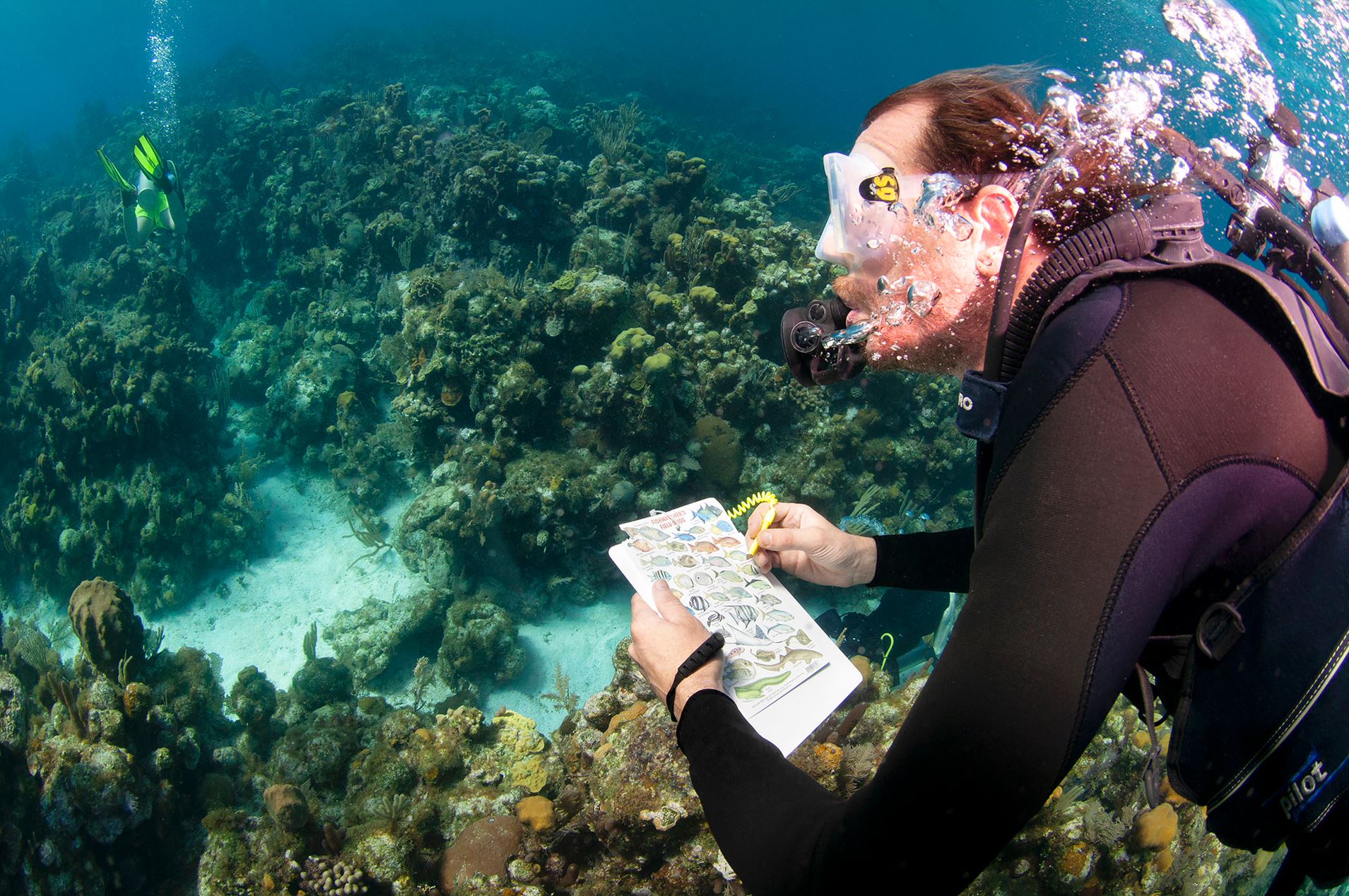
During the Fish Identification Adventure Dive you can learn how to properly identify various groups of fish in Caribbean waters and around the world.
3. Dive with more confidence
With each adventure dive, you gain remarkable growth in your confidence as a diver. By applying your skills in different dive scenarios, you develop the ability to adapt to a variety of conditions and environments. This newfound confidence will enable you to explore with a sense of ease and safety. You’ll know that you have the knowledge and training to handle different situations.
4. Make your dives more interesting
The skills you perform during the PADI Advanced Open Water course add an interesting new twist to diving. This makes it an entertaining course to take, especially if you feel like you’ve seen and done it all in diving or love a good mental challenge. You will try your hand at number games and math at depths to safely learn how nitrogen narcosis can affect decision making and motor skills. You’ll learn how to easily use a compass under water – and on land for that matter! And you can go through an underwater obstacle course to practice staying neutrally buoyant or learn underwater photography basics.
5. It’s required for other courses
The PADI Advanced Open Water is the first continuing education course you need this certification if you have any interest in other PADI courses. It’s a requisite for Rescue Diver and Divemaster. And you must be advanced certified or at least have your PADI Adventure cert in order to achieve most of the PADI specialty certifications. Luckily, the adventure dives also count toward one of the open water dive requirements for all the specialties – so you get some bang for your buck there!
Why Get Your PADI Advanced Open Water in Roatan?
With Roatán’s year-round diving opportunities, you can get certified at any time of the year. Immerse yourself in a wide variety of exhilarating dives, from deep sea swim throughs to intriguing shipwrecks. When you embark on your PADI Advanced Open Water certification journey with Sun Divers you’ll get to learn with a experienced and knowledgeable instructors from diverse backgrounds. You’oll enjoy the advantage of small course groups, ensuring personalized attention and a safe learning environment.
So, is it worth it to get your Advanced Open Water certification?
Whether you’re a recent Open Water certification holder or an experienced diver, the transition to become a PADI Advanced Open Water Diver offers an exciting opportunity to expand your expertise. It’s also a chance to connect more with the worldwide diving community. When you get PADI Advanced Open Water certified, you learn by diving. You will dive more confidently and be able to dive as deep as 100ft (30m). Embrace the thrill of real-world dive experiences, deepen your skills, and unlock your full dive potential.
Are you ready to embark on this extraordinary journey? Contact us to schedule your Advanced Open Water course in Roatan.
4 Types of Divers Who Should Be Diving Nitrox
Many recreational divers know of enriched air (nitrox), but aren’t familiar with it enough to know if they could benefit from diving nitrox.
The benefit of diving nitrox is that you absorb less nitrogen. So it’s safe to say that you should dive enriched air whenever you can. Why? Because with less nitrogen absorption you can enjoy a longer allowable bottom time and also improve your safety margin as it relates to decompression sickness (DCS), when diving on an air profile.
But there are certain types of divers who benefit more significantly from diving nitrox. We’ve identified the 5 Types of Divers who should dive enriched air. Read on to see if you’re one of them!
But first: Are you nitrox curious, but feel like you need a primer on what nitrox is before determining if you should be diving with enriched air? Check out details on nitrox and the PADI Enriched Air Diver course here.
4 Type of Divers Who Should Be Diving Nitrox
1. The ‘Dive All Day, Every Day Diver’
If your primary purpose for vacationing is diving, and your name is on every daily dive possible, then you might consider diving with enriched air – even if your group is following an air profile. Many divers who use it daily for typical-duration dives swear that they have more energy than if they were diving on air. While nitrox has not been proven to reduce fatigue, logically it makes sense since your body is absorbing less nitrogen and not having to off-gas as much.
2. The Liveaboard Junkie
Similarly, if you’re someone who loves liveaboards or is considering one – you definitely want your nitrox certification. Most liveaboards will offer nitrox for free or deeply discount. And that’s smart, because unlike dive centers who typically offer 3-4 dives a day, liveaboards can offer up to 5 dives per day – that’s a lot of residual nitrogen that can build up from dive to dive. A smart way to manage your safety margin on a liveaboard is to dive nitrox on the nitrox profile for the first 3 dives, and then dive nitrox on an air profile for the remaining 2 dives of the day.
3. The ‘Go Deep or Go Home’ Diver
If you get a thrill from deeper depths then nitrox will keep you from pushing your limits (no deco limits that is!). While you can’t necessarily dive deeper on nitrox. This means that you have more time to stay at those depths, assuming you have enough gas, and you’re less likely to “bump up” to your no deco limits when diving at a deeper range. Of course, you still have to be mindful of your the maximum operating depth on nitrox, as it will be shallower than the recreational depth limit we have when using air (40meters / 130 feet.)
4. The Super Safe Diver
If you’re the type of diver who never forgets a buddy check and gets peace of mind from conservative dive profiles, we applaud you and also recommend that you dive with enriched air. Diving nitrox can give you additional peace of mind on your dive, because it’s less likely for you to “push” your no deco limits. And when diving nitrox on an air profile, you can reduce your risk of DCS.
Age, Weight and Nitrox
Two other important factors to consider when choosing whether or not to dive nitrox are age and weight. While no one wants to admit they’re getting older or that they’ve put on a few extra pounds, neither of those factors have to stop you from diving. But the reality is that they can increase your risk of decompression sickness. Nitrogen is more easily absorbed in our fat tissues. And as we age our circulatory systems slow which also slows down the process of off-gassing nitrogen. So if these are factors for you, diving nitrox is a smart decision.
Know that we’ve shared the 4 types of divers we believe should be diving nitrox, and additional health factors that make it a good move, it’s your turn to decide if nitrox is right for you. Not certified to dive with enriched air? It’s a relatively quick and easy course, that is also very cost effective to do while diving in Roatan. Learn more about the PADI Enriched Air (Nitrox) Diver course at Sun Divers!
Can You Dive With Whale Sharks in Roatán?
Roatán is definitely a hidden gem of the Western Caribbean. And a true divers paradise. With its vibrant coral reefs, diverse marine life, and captivating underwater landscapes, it’s no wonder that divers love visiting this tropical island time after time. Whale sharks can be found on the bucket list of many divers. So you’re probably wondering: can you dive with whale sharks in Roatán? Many articles on the internet will tell you, yes. But in our experience, the answer isn’t quite so simple. So we are on the quest to uncover the truth about if you can dive with whale sharks in Roatán with the help of Gabriela Ochoa. She is a local marine biologist, who has recently founded the marine conservation nonprofit Ilili.
Does Roatán have whale sharks?
A frequently asked question by diving enthusiasts is, “Can I dive with whale sharks in Roatán?” While there have been rare sightings of these magnificent creatures near the island, encounters with whale sharks are exceptionally rare. Gabriela explains the chances of spotting a whale shark in Roatán are “once in a blue moon.” The Sea Lucas project, which has developed an interactive map for shark sighting in Roatán and the Bay Islands, reports only 2 reported whale shark sightings in Roatán since 2009. While numbers might be slightly higher due to lack of reporting, this is the most accurate source of data on Whale Sharks in Roatán. Utila, Roatán’s sister island, is considered a better spot for whale shark encounters – but even they have only had 7 reported sightings since 2009. The most common way for us to spot a whale shark is usually from the boat offshore. This means that encounters are very unpredictable and far out in the ocean. For this reason, most encounters end up being snorkel ones.
What is the best time of the year to see whale sharks?
Whale sharks are migratory creatures, traveling vast distances in the search of food and suitable breeding grounds. The presence in any given area is directly influenced by factors such as ocean currents, food availability and migration routes. Contrary to common belief, whale sharks are not vegetarian and feed on zooplankton as well. They have been observed to follow spawning aggregations of fish. Some bigger fish populations such as snappers are usually spawning during a certain season. Because of this, whale sharks are more frequently sighted between December to March around Roatán. Unfortunately, the depletion of fish populations in recent years has resulted in less frequent whale shark encounters in many places – including Roatán.
Diving responsibly with whale sharks in Roatán
While the desire to dive with whale sharks is understandable, it is vital to prioritize their natural patterns and habitats. As migratory species, these magnificent creatures require protection and conservation efforts to ensure their survival and to avoid any disturbance that may disrupt their delicate ecosystem. Unfortunately, many sites around the world that specifically promote whale shark diving might end up overwhelming and leaving these shy giants feeling stressed. At Sun Divers, we believe in practicing responsible and sustainable diving. If there ever is a whale shark sighting in Roatán, you can be sure we will approach it with utmost care and respect.
Unveiling Roatán’s marine treasures
It is not commmon to see whale sharks while diving in Roatán, but the island still offers an array of other captivating marine life encounters. As you explore Roatán reef sites, be prepared to experience a breathtaking variety of wildlife. In Roatán, divers are lucky to frequently encounter turtles, rays, and even some large marine mammals such as dolphins and pilot whales. There is rarely a ‘Turtle Tuesday’ in Roatán where a turtle isn’t showing its face. Of course, there is always an element of surprise and we can never guarantee the sight of specific wildlife while diving.

Two eagle rays are soaring through the waters in Roatán, Honduras.
Contribute to marine conservation while diving in Roatán
Eagle rays are among the stars of Roatán’s underwater world. These magnificent creatures, with their expansive wings and mesmerizing patterns, leave divers spellbound. Spotting an eagle ray gracefully gliding through crystal-clear waters is an experience that will be engrained in your memory forever. Monitoring and mapping of marine animals such as eagle rays and sharks is an important aspect of conservation. For this reason, it is helpful if you take pictures and report your sightings. “There is a lot of power in citizen science. Just contributing a picture can go a long way and has a great positive impact,” Gabriela said. Check out our guide on how to help with conservation.
Looking for a cool way to contribute to conservation while diving? Consider our RMP Coral Ambassador program!
In short – Are there whale sharks in Roatán?
While the chances of diving with whale sharks in Roatán may be rare, this marine paradise offers an abundance of incredible wildlife experiences. Keep an open mind and embrace the underwater wonders that await you. From elegant eagle rays to the vivid diversity of coral reefs, every dive is an opportunity to connect with the ocean’s beauty and contribute to its conservation. By practicing responsible diving, supporting local conservation programs, and spreading awareness about the fragility of marine ecosystems, we can together help protect Roatán’s natural heritage for years to come.
ROA Girls Dive! Scholarship Update
School’s out! And there’s lots of ROA girls blowing bubbles here at Sun Divers thanks to the generous contributions of our dive tribe ??
To date, the scholarship program has supported 4 Discover Scuba Diving experiences, 9 PADI certifications and an exciting day out on the water for some fun diving. We’ve watched these girls develop a love for scuba diving and Roatan’s amazing marine wildlife. And that passion has become infectious! Interest in the program has grown immensely as word has spread about just how cool it is to get to blow bubbles in your own backyard.
Watching these girls embrace new adventures, learn new skills, and even overcome fears & challenges has been nothing but amazing. We’re in awe at how brave and embracing they’ve been in the process. And seeing their pride and smiles shine has been the ultimate reward. Want to share in the joy? Check out our ROA Girls Dive! webpage for a video recap of our latest scholarship activities – and get ready for lots of smiles and high fives!
What’s Next for ROA Girls Dive!
Our next focus is to take all the girls who have been certified and advance them to the next level. That means upgrading Scuba Divers who are certified to dive to 40 feet, to Open Water Divers. And taking our Advanced Open Water Divers to the next level with Emergency First Responder and Rescue Diver certifications.
And, if we’re able to raise more funds, we’ll start a whole new wave of introductory experience and certifications.
How You Can Help
Whether you’re a continuing supporter or just learning about ROA Girls Dive! there are lots of opportunities to help us reach more local girls.
- Join PADI Women’s Dive Day in Roatan: This July 15, we’ll hold our third annual Dip & Sip event. Enjoy some epic Roatan diving, as well as a sunset social at our neighbors Sundowners. Get to meet other women who are passionate about the ocean and diving, while supporting Roatan’s girls. 100% of ticket costs benefit Roatan Peer Health Exchange and the ROA Girls Dive! Scholarship program. Register today!
- Sponsor a Girl to Dive! We’re continuing to raise funds to connect more girls to the ocean and you can help. Donate by visiting the ROA Girls Dive! Gofundme page. Course costs are subsidized by Sun Divers and PADI 76-85% depending upon the course, so it costs $200 – $264 per certification scholarship. And we’re always happy to share updates about the ROA girl that you helped sponsor, just ask!
About ROA Girls Dive!
The ROA Girls Dive! Scholarship program was founded in 2022 to help connect local girls & women to scuba diving. The program is a partnership between Sun Divers, Roatan Peer Health Exchange and PADI – and was developed to increase Roatan’s girls’ access to scuba diving both as a sport and as a profession.
This scholarship program certifies young women in Roatan in all recreational scuba diving courses from Open Water to Divemaster. The program’s goals are threefold: to enrich lives, develop our future’s environmental stewards and create awareness of the professional pathways that these young women can take in the scuba diving industry.
When is the Best Time to Dive in Roatán?
You probably think of Roatán as a great destination to escape the cold during snowy winters. And it is indeed a great place to enjoy the tropical weather of the Caribbean in the dead of winter. But, if you’re coming here for the best diving experience possible, we’ll let you in on a little secret: The summer is the best time to dive in Roatán. Our resident weather expert, Mike Andrews, has been updating weather reports on a daily basis for islanders and tourists alike through his Roatán Weather Facebook page and website. In this post, we’ll share what diving is like year-round on our island. But we’ll also give insights from Mike for those wishing to experience the most perfect conditions. Let’s dive deeper into why summer is the best time to dive in Roatán.
Dive in calm summer waters and explore the best sites
Many great dive sites, including most of our favorite spots, are on the west end of Roatán along the northern shore. And just minutes away from our dive shop by boat. The key to good diving conditions in Roatán is calm and clear waters. On the Northside, conditions can remain calm even when the predominant eastern winds blow. This allows for great visibility and easy navigation. We all love it when we don’t have to fight choppy surface waters and can spot that Eagle Ray from 100 feet away.
Weather expert Mike is a dive enthusiast himself and says, “The greatest conditions for diving are during the summer when the island is mostly free from cold fronts and from wind patterns that can disrupt the waters.” Low winds and calm seas during the summer also give us more opportunities to explore remote dive sites on Roatán’s east end. And also make day trips to the outer islands like Cayos Cochinos possible. While these special day trips can occur year-round, the probability of them happening are higher in the summertime. An extra bonus is that this amazing time of year is considered “low season” on the island. Meaning fewer people and usually lower rates on accommodations and flights. That’s just a few reasons why summer is the best time to dive in Roatán.
Year-round diving in Roatán
The winter months from December to February are the busiest time on the island. During the winter, Roatán can experience periods of strong northern winds up to 35mph/56kmh that push against the Northside of the island. This can potentially lead to murkier and choppier waters on the Northside of the island where we typically dive. We’re not ones to miss an opportunity to dive, so when weather affects conditions on the Northside, we opt to dive on the Southside. See how ‘Southside Days’ allow us to dive all year in Roatán.
The bottom line is that even if summer is the best time to dive in Roatán, you can find great diving year-round in Roatán. Conditions and weather will be more variable during the winter months, but that doesn’t mean that the diving isn’t spectacular. Here are more details on what Roatán weather and diving look like throughout the year.
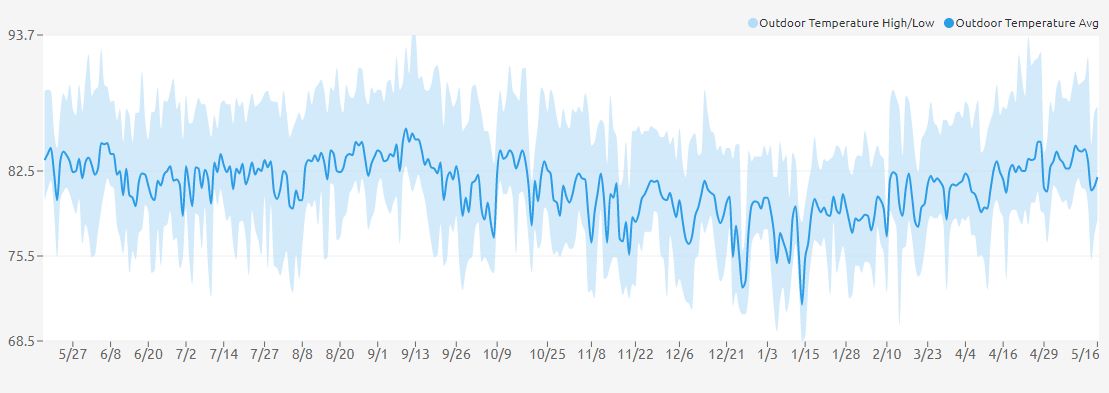
Temperature graph of the average temperature (°F) from May to May in Roatán, Honduras. Daily updates on Roatán weather can be found on Roatanweather.org.
Seasonal Guide to Roatán Weather & Diving Conditions
The summer months offer the best diving conditions in Roatán. But each season has its own unique features that divers might enjoy. Here are some highlights:
A little winter breeze | Roatán diving October – February
The temperature in Roatán averages 86°F/29°C year round. Winter averages are lower at 78°F/26°C with the lowest recorded temps at 66°F/ 19°C. During the winter months of October through February, the island can also feel cooler due to breezier weather.
This by no means requires you to bring your scarf or skiing socks. Days are balmy and skies are usually blue. But, you might not warm up as quickly in between dives. And the waters are slightly cooler at an average of 80°F/ 26°C. So we recommend that you add some additional exposure protection. If you’re one to get cold easily, be sure to wear a full 3mm suit and possibly add a hooded vest. If you usually dive as au naturel as possible – consider just a vest, long sleeve shark skin, or 3mm shorty.
During the winter, the winds can also bring rain fronts. When this happens, we choose dive sites that allow us to avoid areas where there might be runoff. But don’t let the misnomer “rainy season” deter you. We’re on a tropical island so rain is inevitable, but it usually comes and goes quickly and it’s very rare that we can’t find a good spot to dive, rain or shine.

Wind graph shows the average wind speed (mph) from May to May in Roatán, Honduras with cold fronts during the winter highlighted. Daily updates on Roatán weather can be found on Roatanweather.org.
The cool & calm spring | Roatán diving March – June
Weather in Roatán continues to be variable in the spring which is the driest season of the year. But generally winds, albeit high, stick to their predominant easterly direction. This keeps dive conditions calm and above-water temperatures comfortable. Waters start to warm up a couple of degrees and most people start to shed their full wetsuits opting for shorties or rash guards.
While the east winds during this time create ideal diving conditions on the Northside, the Southside of the island can experience waves up to 6 feet high due to the trade winds picking up. This time is perfect for diving on the Northside, but it can be more difficult to dive the Southside due to choppiness.
A hot summer with a Silver Lining | Roatán diving July – September
The island warms up from July to September with low winds and temperatures averaging 84°F/29°C. The water also warms to an incredibly comfortable 84°F/29°C. Low winds mean ultra-calm waters and crystal clear conditions. This is when Roatán’s diving really shines. And when we can adventure more beyond our normal dive sites.
A natural spectacle also takes place during this time of the year. Divers that visit the island can witness the arrival of Silversides, tiny fish that migrate to the island during this time. This incredible play of nature will keep you absolutely mesmerized and wanting to find every silverside-filled swim-through possible. This makes summer the best time to come dive in Roatán!
Check out our blog post about the Spell of the Silversides here.
When is hurricane season in Roatán?
October is the peak of hurricane season in most of the Caribbean, but Roatán is rarely hit directly by major storms. Hurricanes in Roatán are incredibly rare. We’re lucky to be protected by the landmass of Central America. This soothes most storms before they reach the island. But if a hurricane ever makes its way through Central America, the outer bands of the storms can touch the island bringing high winds and rain.
Planning your next dive adventure
True diving enthusiasts will welcome the great diving conditions in the summer. But don’t be swayed by assumptions about winter weather, the “rainy season” or hot summers. It’s true that summer is the best time to dive in Roatán, as Mike our weather expert suggests. But having the flexibility to dive both the North and Southside of the island, usually means we can have great dives, regardless of which way the wind blows.
So pack your dive gear, book your trip, and get ready to explore the scuba diving wonders of Roatán. And let us help you plan the perfect dive trip any time of year.
The Sounds of Sun Divers: Beach Vacation Playlists
While we only like to hear bubbles under water, we love listening to good tunes anytime we’re not under the waves. Whether it’s feeling Irie to some reggae on a surface interval or getting pumped for a new day of diving with some indie pop, music is a major part of the good vibes you’ll feel here at Sun Divers. So much so, we have our own beach vacation spotify playlists.
And just like we curate epic dive adventures, we also curate our playlists to make sure our vibes are just right for your vacation. Here are a few of our favorite beach vacation spotify playlists for your listening enjoyment:
Beach Vacation Spotify Playlists
Beach Skankin’
Nothing quite puts you on island time like a good reggae playlist. We’ve got your classic reggae all stars like Bob Marley & Jimmy Cliff, mixed in with some modern-day Rastafarians like Chronixx.

Cali Vibes
Surf, sand and Sublime made for a California vibe in the 90s that never really went out of style – even if you weren’t alive or oldenough yet to experience it. This playlist will make you wanna throw responsibility to the wind, dive in and chill with the homies by a beachside bonfire. If you agree that “Life’s too short, so love the one you got” and the words “summertime and the living’s easy” speak to your soul, then this one’s for you.
SD Indie Pop
If you’re vacay is about having fun, but also finding yourself as you explore new places, we got the playlist for you. Indie pop is always filled with the fun-loving electro beats of summer, but the deep lyrics will wash over you like the waves of Half Moon Bay. Surfaces, DoubleCamp and Empire of the Sun are just a few of our favorites that make this playlist.
 Funk the Beats
Funk the Beats
No soundtrack to salt life would be complete without a few tunes to bob your head to. This playlist features hooks from hip hop lyricists like the Roots, Tribe Called Quest and Jurassic 5, along with some infusion of jazz, neo soul and funk from the likes of Tyler the Creator and Childish Gambino.
Here’s what else we’re listening to:
Bungalow Beach Vibes – featuring Neko Case, Father John Misty, Big Thief
SD Soul – featuring Raphael Saadiq, Mayor Hawthorne, Erykah Badu and Stevie Wonder
SD Internacional Sounds – featuring Gorillaz, M.I.A., Saint Levant and Manu Chao
Surfer Grooves – featuring Khruangbin, King Gizzard & Lizard Wizard, Babe Rainbow and Peter Lake
Psychedelic Pop – featuring Tame Impala, MGMT, Unknown Mortal Orchestra and Local Natives
Afrobeach – featuring Wizkid, Burna Boy, Asake and Fireboy DML
Have a favorite song, you love to listen to when you’re getting ready to dive or just boat & float? Tell us what you’d love to hear us play in our shop and we’ll add it to our beach vacation playlists.
DIY: How to Paint Scuba Diving Fins
Add some flair to your scuba diving equipment with these easy instructions on how to paint your scuba diving fins.
As dive equipment goes, there is not much that you can do to add your own sense of style beyond choosing unique colors and maybe a colorful rashguard. But you can let your individuality shine by using non-toxic paints to add some personal flair to your fins – and stand out on your next dive.
Why Paint Your Scuba Diving Fins
In addition to taking your dive style to the next level, there are some practical reasons to paint scuba diving fins. If you’re an instructor or divemaster, they make you easy and spot to follow in a dive group. If you’re a recreational diver – you can rest assured, you’ll never lose your fins in a busy shop or on a busy boat. Or worse, mistake your fins for someone else’s…Trust us, this happens more often than you think!
But at the end of the day, painting your scuba diving fins is just a fun way to show off your own unique style.
Sun Divers hosted a fin-painting party for our dive tribe here in Roatan.
Here are the tips & tricks we learned are best for long-lasting, personalized designs on your scuba diving fins.
How To Paint Scuba Diving Fins
Step One: Wash & Dry Your Fins
Use soap and warm water to remove salt, sand and dust from your fins. Wash thoroughly and then towel or air dry.
Step Two: Sand Your Fins Down
In order for the paint to stick to your fins, you need to scuff up the surface. To do this, use XX mm sand paper and scuff up the area where you want to paint the fins. If you find that the paint is bleeding when you go to design, that’s a sign that you need to sand your fins down even more.
Step Three: Get Creative with (Non-toxic) Paint
From there, the world is your oyster. Go crazy with color adding any touches to your fins that speak to you. If you’re great with freehand, just go for it. Or you can sketch your design out first with pencil – erasing where needed. These stencils were a life saver for some of us. But be careful because on some fin surfaces the paint can bleed under the stencil just creating a big blob of color. This is especially true if you’ve not sanded your fins down enough.
Be sure to use non-toxic, water-based paint. You can find usually find paint markers at a local craft store or online.
And it’s nice to have a series of acrylic paint brushes with different tip shapes and sizes for finer details.
Step 4: Allow your fins to dry
You’re going to want to use them right away. And you’re going to be tempted to touch the paint to see if it’s dry. DON’T. Just be patient and let your fins dry for at least 24 hours to be safe.
Other Scuba Fin Painting Tips
- Acetone is your friend. If you make a mistake (which you wil), it’s the magic eraser!
- Do NOT use lacquer. We did our research beforehand, and some blogs suggested applying a spray lacquer to seal in the design. One person tested this and it dulled the paint pens and eventually flaked off. The outcome was fugly fins and the potential for lacquer to end up in the ocean which is no bueno in our book.
- Go abstract! If you still draw like you’re in kindergarten (raises hand ?) then avoid detailed imagery and just go with an abstract design when you paint your scuba fins. This will be much more forgiving for any errors.
Now you have all our best tips for how to paint scuba diving fins. Check out some of our dive tribes creativity for inspo!


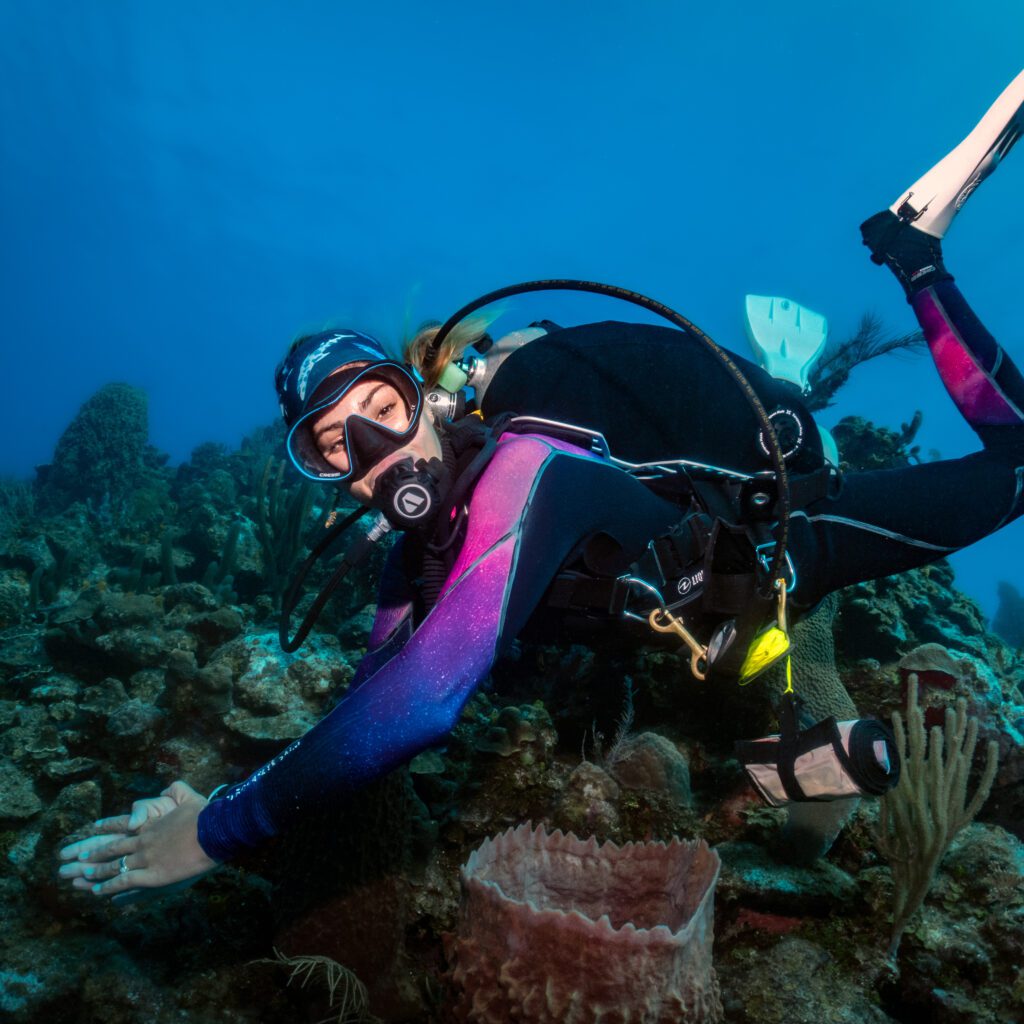
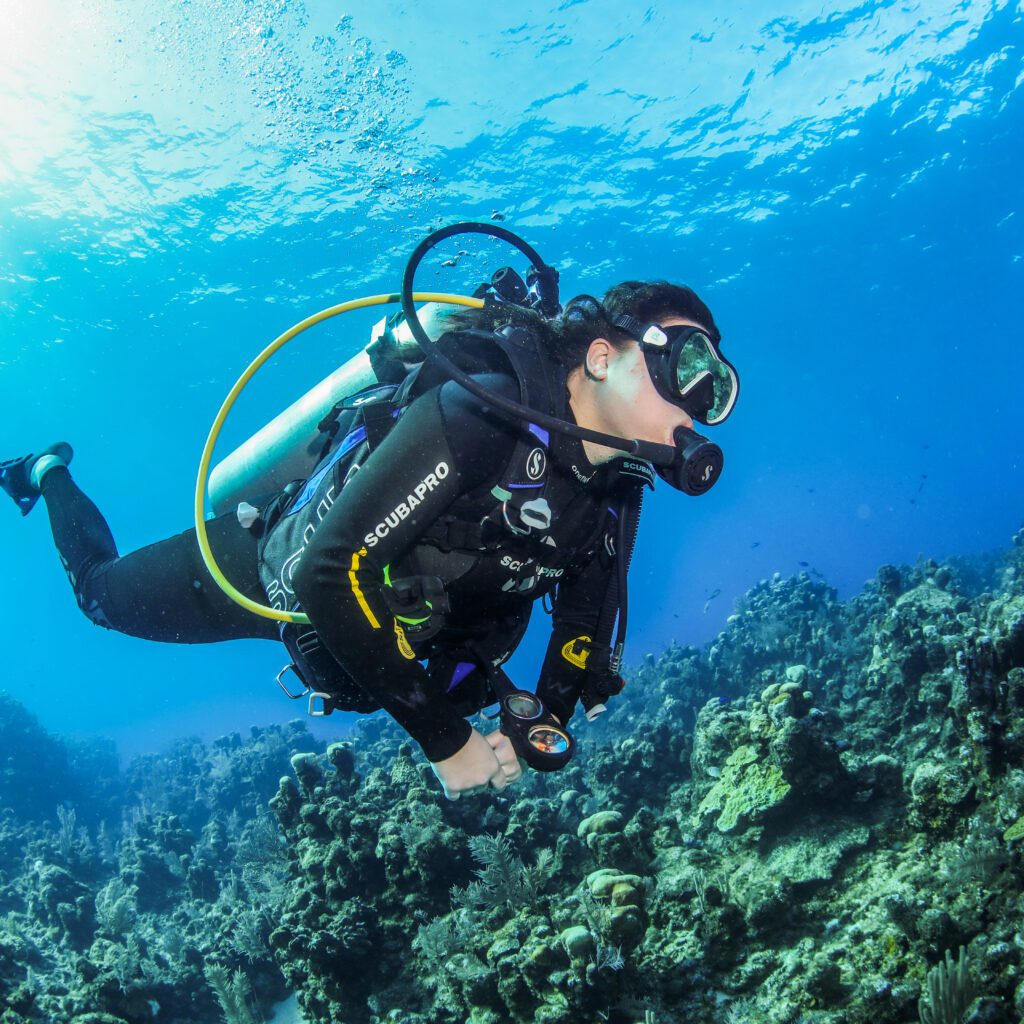
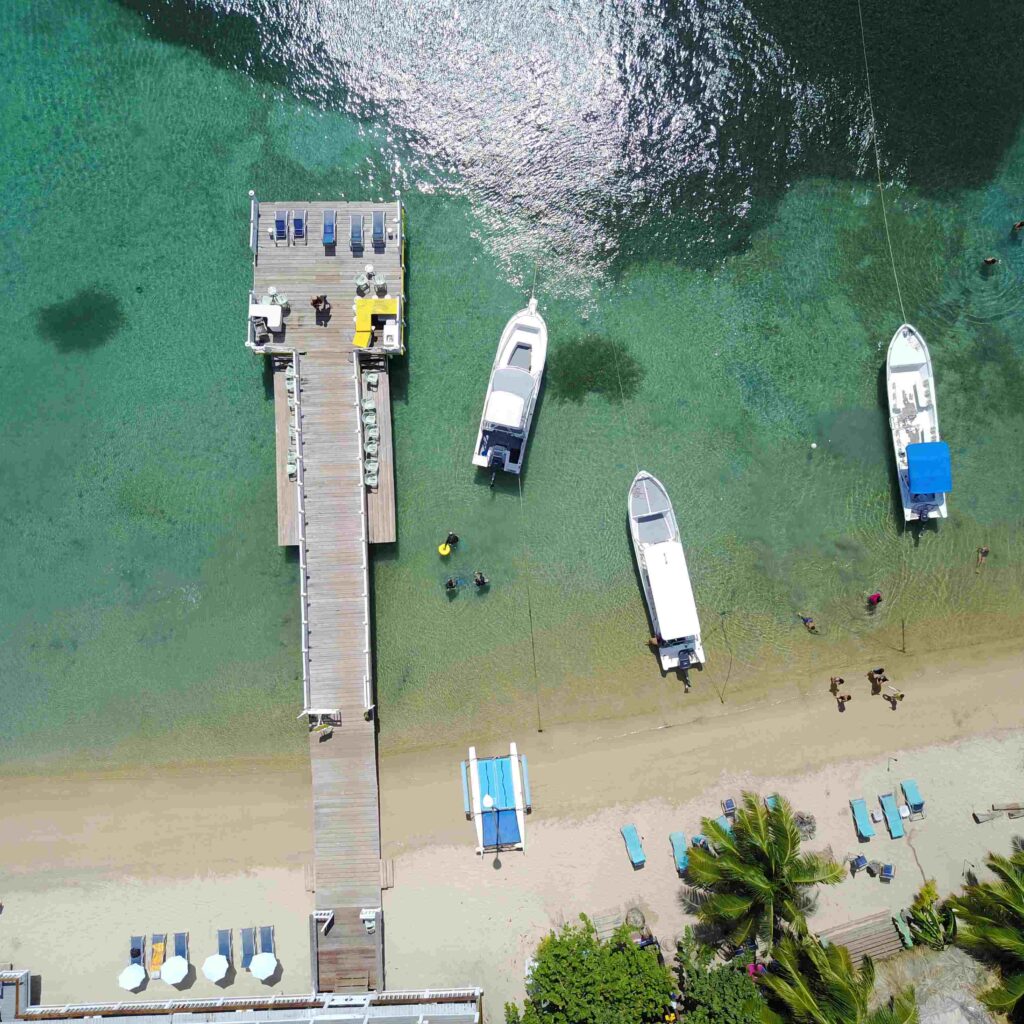
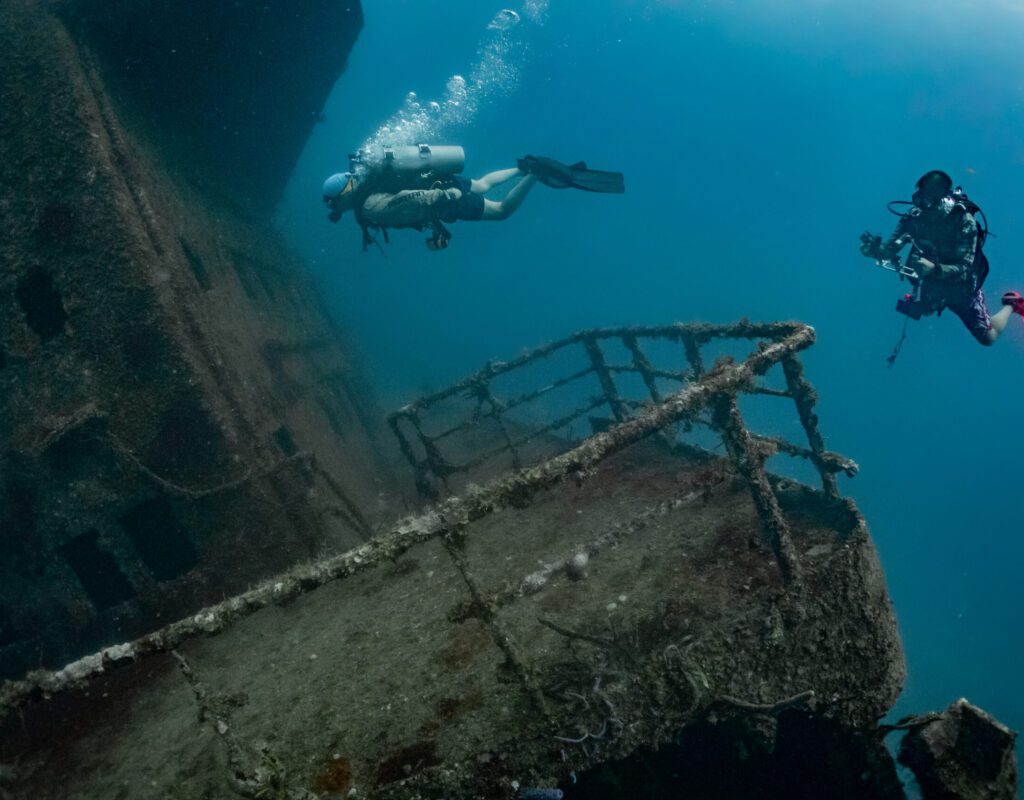
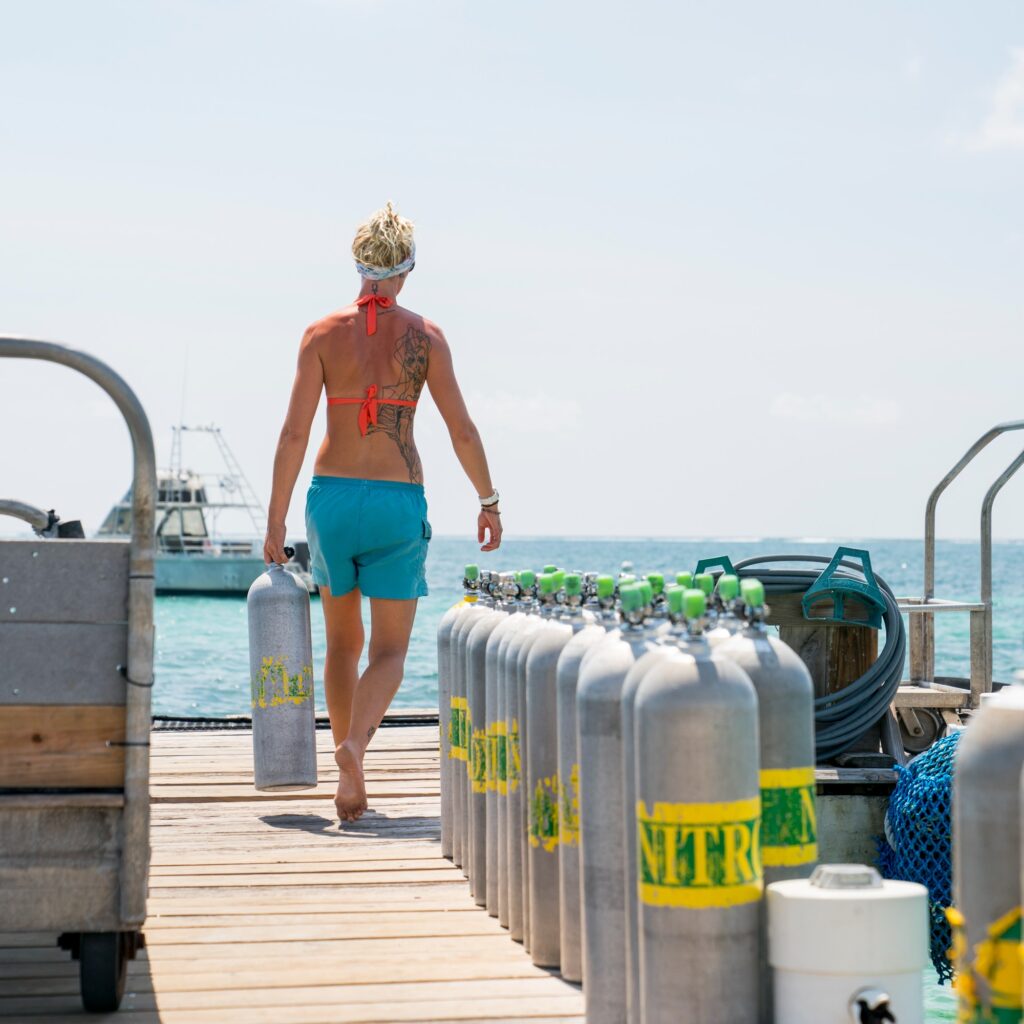
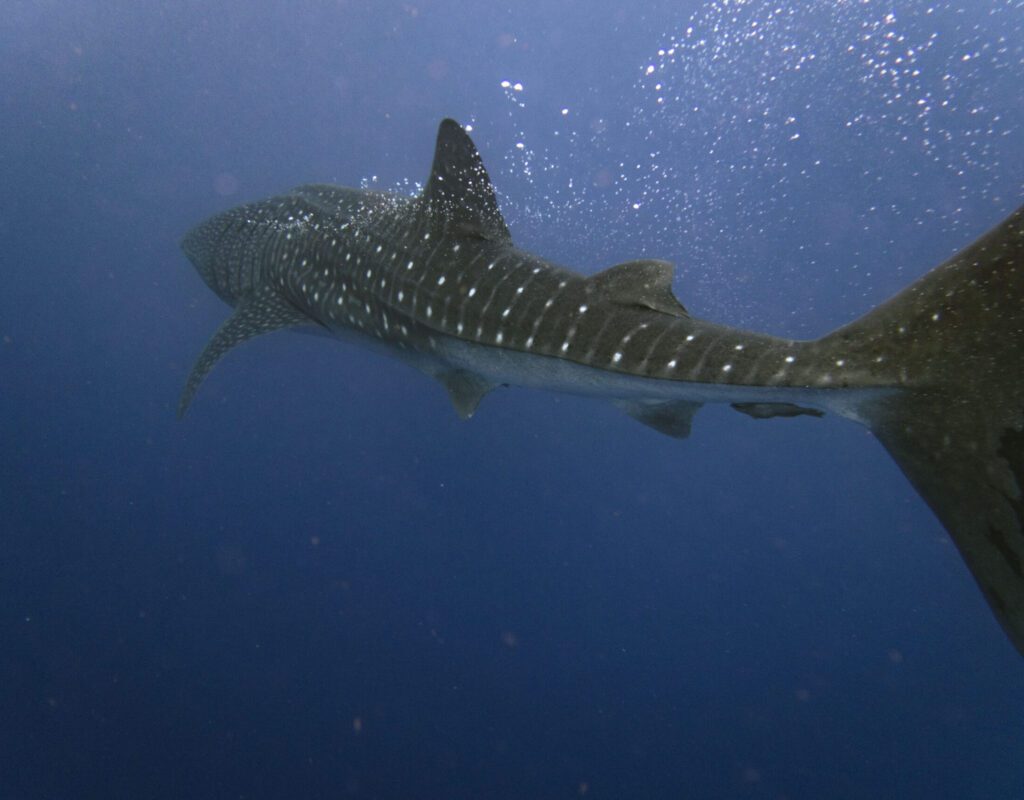

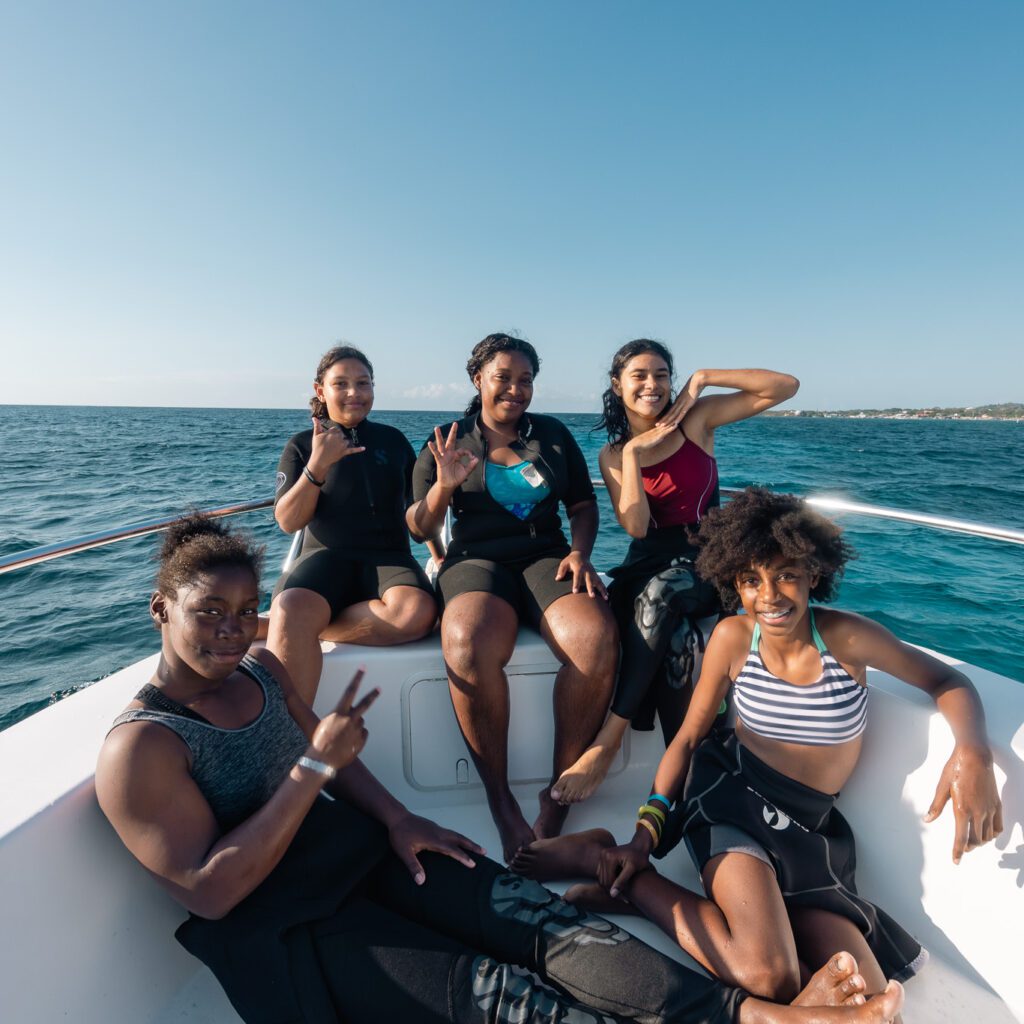
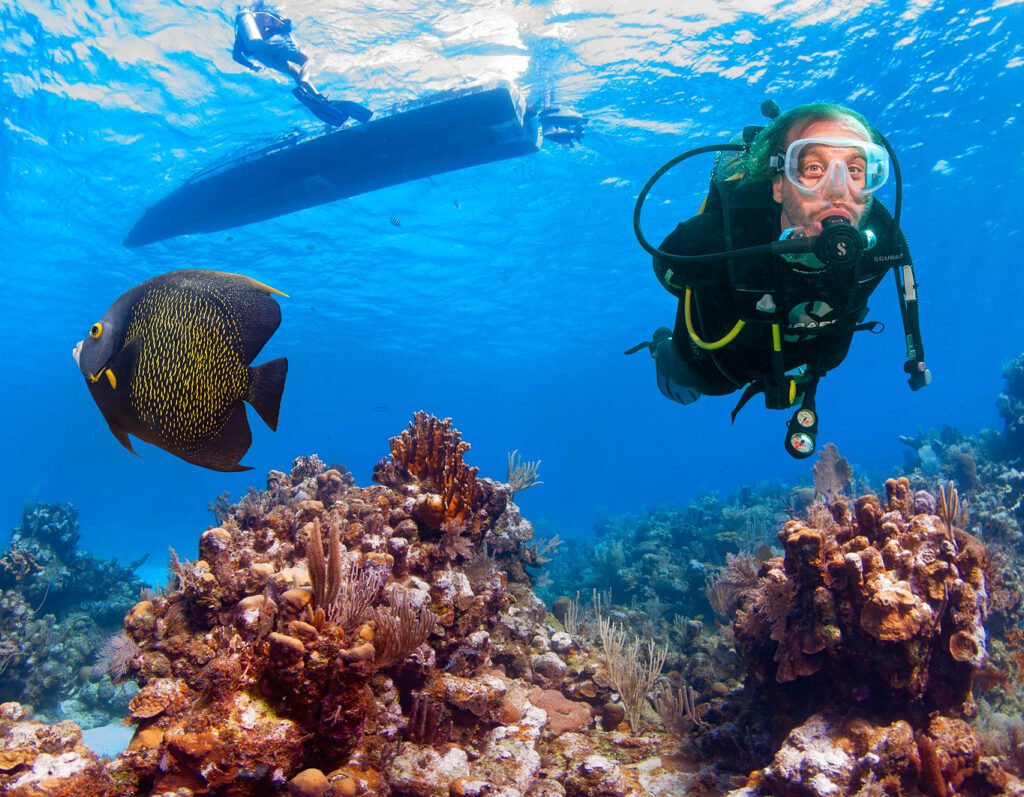
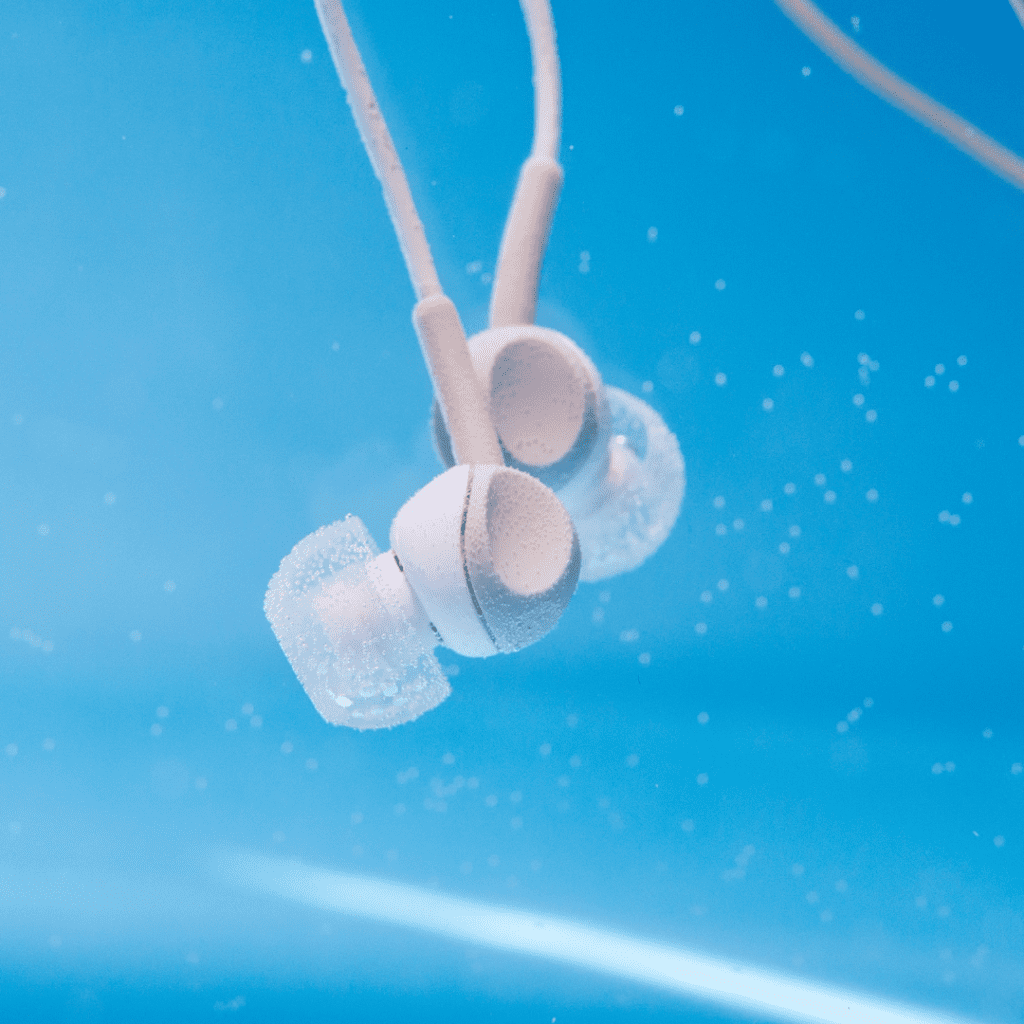
 Funk the Beats
Funk the Beats